Ireland & the Olympic Games
Published in 18th–19th - Century History, 20th-century / Contemporary History, Features, Issue 1 (Spring 1998), Medieval History (pre-1500), Volume 6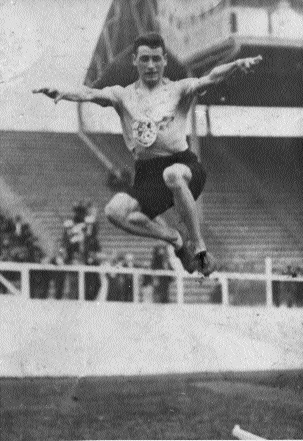
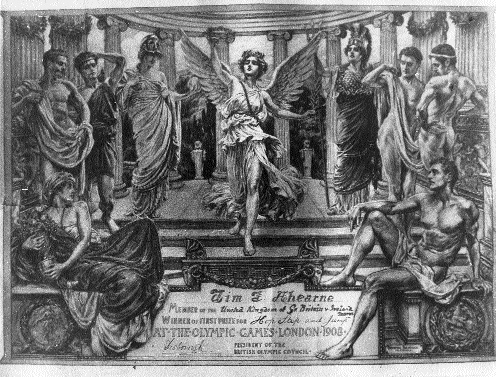
Tim Ahearne’s certificate for the gold medal in the ‘hop, skip and jump’ (triple jump) in the 1908 London Olympics.
Baron de Coubertin’s idea that athletes world-wide should emulate the games of ancient Greece came to fruition over a century ago. Although the aura and ethos of the games have since been eroded by nationalism, racism, commercialism and international politics, their appeal has continued unabated, giving rise to quadrennial outbursts of global euphoria. Michelle Smith’s achievement of three golds and one bronze at the 1996 Atlanta Olympics meant that Ireland was no exception and it prompts an examination of the country’s various roles and achievements in the Olympic movement and the socio-political factors which influenced, inhibited and even impeded its participation in the games.
Indigenous athletic tradition
The era of the ancient games of Queen Tailte may be a matter of historical conjecture, but even by the most modest estimate their time-span (303 BC-AD 1168) was longer than that of the ancient Greek Olympics. Long before the Great Famine, running, jumping and the throwing of weights were well-established peasant pastimes, while the cross-country nature of some hurling and football (caid) contests, spiced with inter-parish or inter-county rivalry, added a further dimension to this sporting fervour. These activities, though governed by local rules, lacked any central controlling organisation. Such a structure only emerged in the second half of the nineteenth century with the establishment of the Irish Champion Athletic Club, although this was more of an offshoot of the English Amateur Athletics Association, confining its membership to ‘gentlemen’ and the professional classes. The ICAC had a lease on a field at Lansdowne Road, but at the end of the 1870s was beset by many problems: falling standards, betting and increasing professionalism, as well as class antagonisms. Consequently, the Gaelic Athletic Association was founded to introduce a democracy into Irish sport and to dispel any fears that traditional Irish sports might be neglected.
Gaelic Athletic Association
Michael Cusack and Maurice Davin, who had competed under the ICAC rules, founded the GAA at Thurles on 1 November 1884. Their five other co-founders included two journalists (one from Belfast), a solicitor, a policeman and the father of a future British government minister. The founders’ aims were the preservation and cultivation of national pastimes and initially the emphasis was almost entirely on athletics. Archbishop Croke, its first patron, regarded the GAA as part of a national cultural revolution. Fenian and Land Leaguer Michael Davitt, meanwhile, was prompting Cusack to revive the Taltine (sic) Games.
The first athletics meeting under GAA auspices was held at Macroom, just ten days after the historic Thurles meeting. Yet, within a few months, there were two ruling bodies as the anti-nationalist ICAC became the Irish Amateur Athletic Association at a specially convened meeting. Both associations operated reciprocal boycotting of one another’s activities in 1885, but the GAA rescinded its exclusion rule under the influence of Croke who did not think that one association should boycott the other ‘to the extent of not allowing a man who had competed for a prize or championship under one set of rules to contend for a like prize if offered by an athletics association whose rules were different’. With the lifting of the ban, there appeared to be an easy movement of athletes between the two associations.
Some would argue that the GAA’s opposition to the IAAA had more to do with political motivation than a mere desire to establish an athletics democracy. Members of the Fenian Brotherhood infiltrated and soon controlled the GAA’s executive council. Shortly after, Cusack and Davin parted company with the infant association and the 1887 convention was a noisy, divisive affair. The nationalist Irishman contended, for instance, that: ‘If any two purposes should go together they ought to be politics and athletics, our politics being essentially national so should our athletics’. Games took second place to politics for some time and almost wrecked the Association, as some priests and moderate nationalists battled to break the Fenian hegemony. Eventually, neutrality-at-the-top allowed the GAA to flourish.
The GAA ensured that Irish sport would be organised by Irishmen and that rules were drafted to aid the revival of Irish pastimes. Proletarian participation mushroomed and throughout the 1880s and ‘90s the GAA’s athletes, epitomised by Tipperaryman Tom Kiely, matched the enthusiasm of founders Cusack and Davin as a stream of Irish records were set in a variety of events.
Golden age
While Irishmen figured quite prominently when Baron de Coubertin’s concept finally bore fruit in 1896, the expense of travelling far from home as well as allegiance to radical GAA ideals prevented some athletes from competing at the Olympic Games until 1908. Although not without flaws, the London games of 1908 established the festival firmly in the sporting calendar and revived the drooping Olympic spirit after the poorly-organised and poorly-attended St Louis, USA, ‘World Fair’ Olympiad.
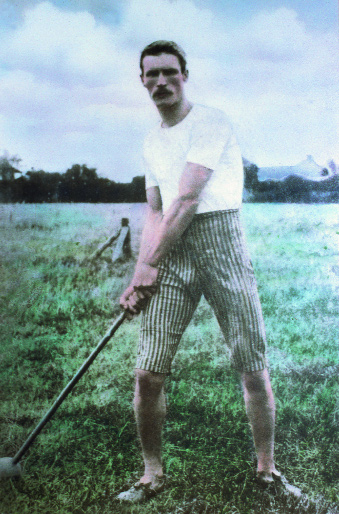
Tom Kiely of Carrick-on-Suir, all round (decathlon) gold medal winner at the 1904 St Louis Olympics, refused the offer of expenses to represent the English AAA and competed as ‘Tom Kiely of Tipperary and Ireland’. (Tipperary SR County Museum)
They also demonstrated the strength in depth of Irish athletics. Native-born Irishmen, collected as many as eight gold, seventeen silver and eight bronze medals in fifteen different disciplines. Included in this galaxy were such famous figures as: Martin Sheridan (discus), Bohola; Tim Ahearne (triple jump), Athea; John Flanagan (hammer), Kilmallock; Robert Kerr (100 and 200 metres), Enniskillen; Matt McGrath (hammer) and John Hayes (marathon), Nenagh; Con Leahy (high jump), Charleville; and Denis Horgan (shot put), Banteer.
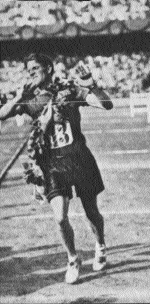
Irish-born Kyle McArthur won the marathon for South Africa at the 1912 games in Stockholm. (The Game)
Never before nor since did Irish athletes garner such a harvest at a single Olympiad. Moreover, certain features are readily discernible, notably, the traditional Irish penchant for weights. At London, Irishmen occupied the first three places in the hammer event: Flanagan, McGrath and Con Walsh. This was Flanagan’s third successive Olympic gold, to be emulated by McGrath (1912), Ryan (1924) and Dr Pat O’Callaghan (1928 and 1932).
After 1908 Irish Olympic honours were less frequent. Los Angeles 1932 provided the next peak in performance when three medals returned home: O’Callaghan; Bob Tisdall won gold in the 400 metres hurdles; Sam Ferris, an RAF officer from County Down, won silver for Britain in the marathon; while Éamon Fitzgerald, a member of the all-powerful Kerry gaelic football team, narrowly missed out, coming fourth in the triple jump. O’Callaghan and Tisdall were all-rounders in the traditional mould of Davin, Mitchell, Kiely and Sheridan. This O’Callaghan proved in 1930 when he tied for first place in the high jump during a triangular match with England and Scotland, taking his considerable frame over the bar at six feet two inches. He held five Irish championships that year. Tisdall, as well as winning the 400 m. hurdles, came a respectable eighth in the Los Angeles decathlon.
Competing allegiances
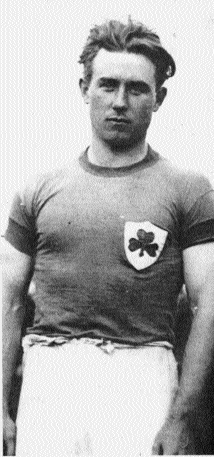
The problem of rival sporting associations in Ireland was reflected in international competition between national teams. Success at world level has ever been the ultimate goal in the individual’s pursuit of glory. In most countries this was not an issue. However in countries such as Ireland, comprising more than one cultural entity, participation and success in international competition raised the serious question of identity and allegiance. It is no consolation now to learn that it was the great powers—Britain, the USA and later Nazi Germany and the Soviet Union—which developed the cult of nationalism in Olympic sport and which was definitely not in accord with de Coubertin’s founding principles. Irishmen have often been uneasy about the colours raised on their behalf with nationalists firmly opposed to the Union Jack and unionists equally reluctant to recognise the Tricolour.
Of the huge Irish medal tally in 1908, three gold, four silver and one bronze were accredited to Britain. The remaining awards boosted the medals totals of the USA and Canada. Contemporary reports held that ‘the Irish athletes were furious because they had to take part under the colours of Great Britain and their successes would not be credited to Ireland’. There was nothing new in this. Following the presentation ceremony at the Intercalated Games at Athens in 1906, the winner of the triple jump—Peter O’Connor from Wicklow—shinned up the flagpole and replaced the Union Jack with a green flag embellished with shamrock and the words ‘Erin go Brath’. Such incidents pointed clearly to the deep-rooted antipathy towards Britain felt by nationalistic Irish athletes at the time. When Tom Kiely from Carrick-on-Suir was offered his expenses on condition that he compete for the English AAA at St Louis in 1904, he raised his own funds and proceeded to win the world all-round championship. As late as 1928, Dr Pat O’Callaghan confessed that: ‘I am glad of my victory, not for the victory itself, but for the fact that the world has been shown that Ireland has a flag, that Ireland has a National Anthem and, in fact, that we have a nationality’.
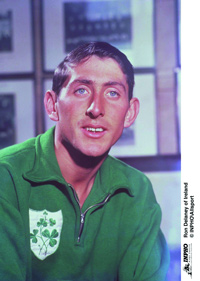
Ronnie Delaney-almost didn’t travel to Melbourne in 1956 due to domestic organisational wrangling. (INPHO/Allsport)
Short-lived athletic unity
Before the second Paris Olympiad of 1924, Irish athletes ‘carried the flag’ for other countries. At Paris, Ireland’s fully accredited team participated for the first time in the ceremonial parade of the nations and continued to do so with but one exception: the ‘Jesse Owens’ games at Berlin in 1936.
Mainly as a result of the Parnell split, the GAA was in a very poor state at the beginning of the twentieth century, and athletics suffered accordingly. Recovery was slow and around 1906 any degree of co-operation which had previously existed with the IAAA, whose influence was largely confined to the Dublin area, disappeared. The traumatic events of 1913-23 didn’t help. Nevertheless, in May 1922, the GAA ceded its role in athletics to the National Athletic and Cycling Association (of Ireland), newly established to control athletics throughout the island. Shortly afterwards, the IAAA decided to amalgamate with the new body so that for the first time there was a single governing authority for Irish athletics. An Irish Olympic Council was set up at the same time.
The NACA(I) was unanimously elected to full membership of the International Amateur Athletics Federation at its Paris congress in 1924. A few weeks later, a thirty-two-county team participated in the eighth Olympiad, marching behind the Tricolour. Notwithstanding this encouraging development, uneasy rumblings almost immediately followed which suggested that the burning question of athletic unity had not been settled conclusively.
In 1925 the NACA(I) was forced to warn a number of Ulster clubs after reports were received of toleration of pony racing and gambling at sports meetings. The Northern clubs contended that such activities were necessary to maintain spectator interest. However, when their motion to this effect was overwhelmingly defeated at the 1925 annual congress, ten clubs from Ulster withdrew from the Association. Subsequent efforts to draw them back proved futile, but this internal rift might not have developed into a full-blown crisis were it not for the intervention of the English AAA.
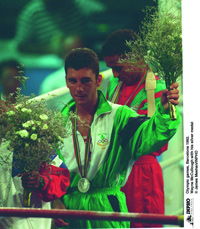
Boxer Wayne McCullough from Belfast’s Shankill Road area wins a silver medal for Ireland at the 1992 Barcelona Olympics. (James Meeham/INPHO)
International and domestic wrangling
The ten Northern clubs founded the North of Ireland Amateur Athletic Association and this group was formally recognised by the English AAA in 1930. The NACA(I) immediately protested to the International Amateur Athletics Federation, which heard the complaint at a meeting in London. The British responded by suggesting that the NACA(I) should confine its jurisdiction to the twenty-six counties. After a protracted discussion, the matter was referred to the Los Angeles congress in 1932.
The first clear evidence of the manner in which events were about to unfold came in 1931. As president of NACA(I), General Eoin O’Duffy, a delegate to l’Union Cycliste Internationale, accompanied the Irish cycling team to the World Championships in Copenhagen, where he pleaded the cause of thirty-two-county organisation. Count de Baillet-Latour, the president of the International Olympic Committee, ruled however that national associations should confine themselves to political boundaries and that what had been tolerated in Ireland during the 1920s was a mistake needing rectification. Nevertheless, the NACA(I) position was confirmed at Los Angeles where a Poland/Italy motion—that no further discussion on the issue should take place—was carried by a two to one majority. Furthermore at the opening ceremony of the Los Angeles Games a short time afterwards, O’Duffy intervened successfully so that the country’s designation was changed from ‘Irish Free State’ to ‘Ireland’. Yet the signs were indeed ominous.
It was now clear that the athletics authorities in Britain were orchestrating every move. They had not accepted the Los Angeles decision and in 1933 a board was established which, in effect, amalgamated the AAAs of England, Scotland and Northern Ireland. The IAAF received and ratified the affiliation of the new body. Again the NACA(I) protested vehemently but, in turn, was warned by Sigrid Edstrom, the president of IAAF, that it risked suspension if it did not accept the new arrangement. It soon became clear that the British AAA was also hard at work elsewhere. At the Stockholm congress in 1934, the whole tenor of the previous congress was put standing on its head when the new arrangement was ratified by a mere nine votes; ten countries abstained; only Ireland voted against; and there was not even a majority of delegates present.
Before the Stockholm vote took place, one of the Irish delegates was approached by Harold Abrahams (of Chariots of Fire fame) who intimated that if a substitute for the Tricolour was found for international competitions, Britain would not oppose the Irish stand. Dublin’s response was swift. At the first European Games at Turin there was no NACA(I) team, having previously withdrawn from the International Cross-country Championships in Wales, following the acceptance of an entry from Northern Ireland. At its annual congress, delegates refused to accept the IAAF ruling by a small majority. Events ran their course and in 1935 the NACA(I) was suspended by the IAAF, as well as from all further international competitions.

Boxer Francis Barrett carries the flag for Ireland at Atlanta, 1996. (Billy Strickland/INPHO)
In the light of these developments the Irish Olympic Committee discussed the issue of participation in the forthcoming Berlin Olympics. Cunningham, the Swimming Association representative, urged the Council not to adopt a hasty resolution on the issue, but was strongly opposed by representatives of the NACA(I), the GAA, the Irish Amateur Boxing Association and the Handball Association. The meeting forwarded a motion to the International Olympic Committee that it was against sending any team other than a thirty-two-county one, but was ignored. Permission to address the organising committee was refused and when NACA(I) officials travelled to Berlin, they received no satisfaction after an informal meeting with IOC president, de Baillet-Latour, who believed the matter would have to be settled in Ireland. So there was no Irish team at the Berlin games and given the travesty manufactured by the Hitler in 1936, it is possible to smile wryly at Ireland’s woes.
Fission
In November 1936, the Irish Olympic Council discussed a letter, which the NACA(I) had received from the IAAF, informing them that another association was about to be formed within the Free State which would be willing to accept limited jurisdiction. It contained the veiled threat that this association would be recognised if the NACA(I) did not accept the international ruling. One of its officials, J.J. Keane, thought that the split with the Northern Ireland AAA could be settled under a four provinces flag for international competition. His own association did not agree with him and its congress refused to budge on the issue of partitionist limitation in 1937. Accordingly, it was permanently expelled from the IAAF and suffered immediate fission as one Clare and six Dublin clubs broke away to establish the Irish Amateur Athletics Union, later known as the Amateur Athletics Union of Éire. The new athletics body, of which there were now three in Ireland, was admitted without delay to IAAF. Meanwhile, the cyclist wing of NACA(I) broke away to form a separate National Cycling Association in 1938, followed by yet another cycling association, Cumann Rothaíochta na hÉireann. Not to be outdone, some northern cyclists accepted the umbrella provided by the British National Cycling Union.
London 1948
Early in the summer of 1948 the IAAF intimated that it would re-examine the expulsion question, or so rumour had it. On this basis the NACA(I) nominated five athletes whose names, by some quirk of bureaucratic bungling, were inserted in the programme for the London games. However, Commandant Chisholm, already appointed the games’ chef-de-mission by the Irish Olympic Council, received official notification that these entries would not be ratified. Moreover, the entries of the AAUÉ did not receive clearance from the Irish Olympic Council, who regarded their athletes as traitors. Nevertheless, these entries were forwarded and accepted by the relevant authority in London. The deep-rooted animosities still burning as a result of the athletics split manifested themselves yet again as the Irish Olympic Council refused to recognise AAUÉ participants, who were forced to contact the games’ administrator before accommodation was provided for them. The NACA(I) sent a cycling team but, when they refused to accept the ruling on jurisdiction, they too were excluded.
Éire or Ireland?
The Irish Olympic Council had been informed by the international body in 1939 that, in the light of the wording of the Irish Constitution, the official designation at future Olympics would be ‘Éire’ (despite the fact that the English form of the name, ‘Ireland’ is also used in the same document). This provided yet another bone of contention. Irish officials made an official protest but eventually accepted the ruling. Nevertheless at the games opening ceremony the Irish squad formed ranks behind Iraq, only to be informed by British officials that their place lay behind Egypt, despite the instruction to participants to assemble in alphabetical order according to the English version of their country’s name. AAUÉ participants, meanwhile, marched at a little distance behind the other Irish competitors, ‘second class’ athletes, apparently, in the eyes of the Irish Olympic Council.
The third area of disagreement was the sensitive question of dual-citizenship. On the British team was a small number of competitors born in the Twenty-Six Counties, to whom the Irish Olympic Council offered no objection. Yet Britain strenuously opposed any Irish entry born in the Six Counties. Fern, the English president of le Federation Internationale de Natation Amateur, ruled that northerners McCartney and Jones of the Irish swimming team could not take part, provoking the late withdrawal of the entire Irish swimming squad. To make contradiction more contradictory, the Irish Amateur Rowing Union—a thirty-two-county organisation which was also a member of the international governing body—included Belfastman Danny Taylor in its team at Henley.
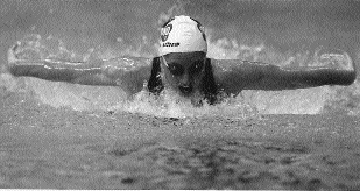
Ireland’s most successful Olympian Michelle Smith in action. (Irish Times)
Olympic politician
It was not until 1952 that the International Olympic Committee conceded the right of Irish citizens born in Northern Ireland to compete for Ireland. At about the same time the home body’s designation was changed rather subtly to the Olympic Council of Ireland. In that same year, Lord Killanin, the recently elected president of the Irish Council, was admitted to the IOC with the support of Lord Burghley. Still the ‘battle of the names’ continued. Killanin persuaded Avery Brundage, the IOC president, to accept ‘Ireland’ as the country’s designation for the 1956 Melbourne games and the IOC followed suit, in spite of Burghley’s opposition. Killanin was later forced to protest over the continued use of ‘Éire’ by the IAAF, presided over by Burghley, the only association which did not accept the IOC’s decision. On this occasion, however, Brundage had the last word. With Ronnie Delany on the victor’s podium following the 1500 metres final, the IOC president made it clear that he was presenting the gold medal to ‘a gentleman from Ireland’. Meanwhile domestic wrangling continued unabated in the icy relationship between a majority in the Olympic Council of Ireland and the AAUÉ. A severe shortage in funding had exacerbated the situation with a difference of opinion about sending Delany to Melbourne in the first place! Also at Melbourne there was the unedifying spectacle of two rival Irish cycling teams presenting themselves and their squabbles to the world at large. Such myopia is balanced, however, by the outstanding service given to the Olympic movement by Lord Killanin, president of the IOC from 1972 to 1980, duly acknowledged at Paris in 1994 when he was made an honorary life member.
Patrick O’Sullivan is retired principal of St Colman’s Boys School, Kanturk, County Cork, and an editor of Seanchas Dúthalla.
Further reading:
S. Ware, Laochra na hÉireann agus na Cluichí Oilimpeacha (Báile Atha Cliatha 1995).
D. Guiney, Ireland’s Olympic Heroes (Dublin 1965).
J. Sugden & A. Bairner, Sport, Sectarianism and Society in a Divided Ireland (Leicester 1995).
















